| |
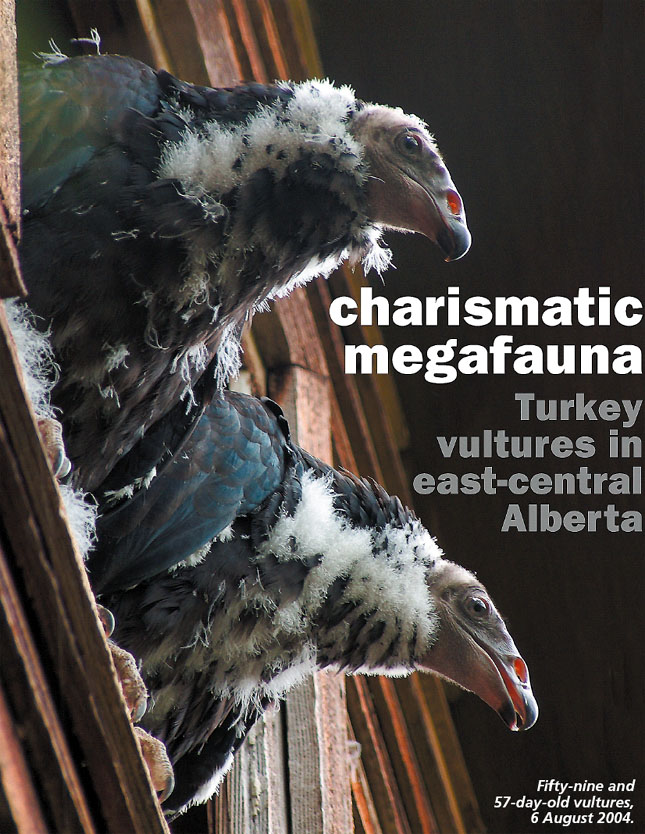
|
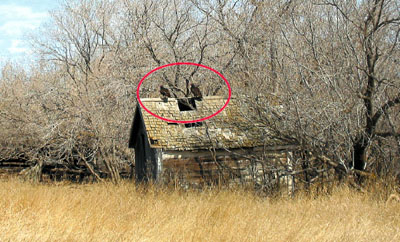
Mid-late
April
and
a
pair
of
turkey
vultures
check
out
a
shed
for
nesting
near
Wainwright.
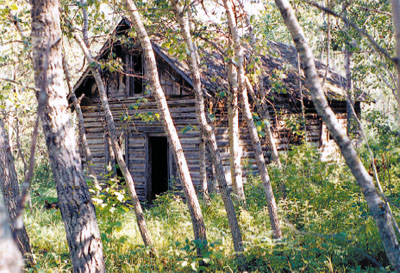
Surrounded
by
aspen
re-growth,
this
abandoned
farmhouse
near
Ernestina
Lake
had
vultures
nesting
upstairs.
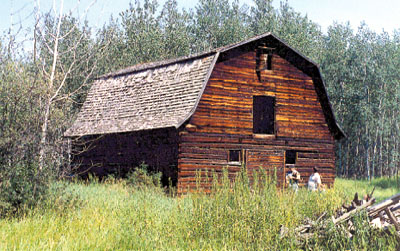
An
old
barn
with
vultures
nesting
in
a
manger
accessible
by
the
small
lower
windows.
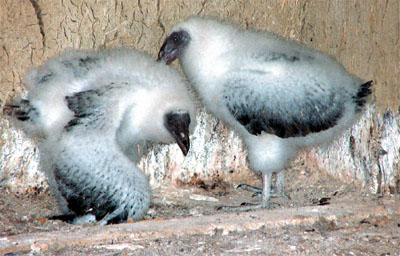
Thirty-five
and
33-dayold
vulture
chicks,
July
13
2004,
near
the
North
Saskatchewan
River
south
of
St.
Paul
.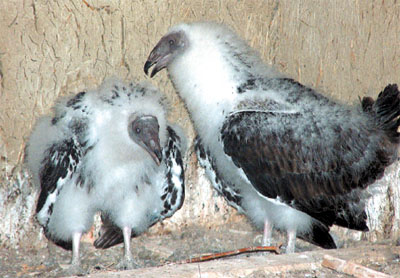
Forty-two
and
44-
day-old
vultures.
Note
the
whitewash
on
the
walls. |
By
R.
Wayne
Nelson,
Floyd
Kunnas,
and
Dave
Moore.
Charisma?
Despite
its
almost
two-metre
wingspan,
its
amazing
ecosystem
function
and
services,
and
its
spectacular
soaring
ability,
it
is
difficult
for
some
people
to
refer
to
turkey
vultures
as
“charismatic
megafauna”,
but
they
definitely
are.
Their
wingspan
is
three-quarters
that
of
golden
and
bald
eagles.
Their
naked
heads
are
like
those
of
turkeys,
which
prompted
their
name,
but
the
function
of
that
nakedness
is
entirely
different.
As
large
avian
scavengers,
vultures
clean
up
large
and
small
“deads”
by
ripping
through
skin
or
holes
in
dead
animals
and
eating
the
material
inside.
Inside
a
dead
cow
or
road-killed
deer
can
be
very
messy
and
a
naked
head
is
a
valuable
adaptation
for
avoiding
a
“bad
feather
day”.
Vultures
sometimes
feed
on
road-killed
skunks,
which
may
seem
gross
to
us,
but
is
obvious
to
vultures
because
they
have
an
amazing
sense
of
smell.
In
contrast
to
most
other
land-birds,
turkey
vultures
can
smell
well
and
can
locate
even
lightly
buried
decaying
meat
from
long
distances
downwind.
We
are
stretching,
perhaps,
but
even
that
adds
some
charisma.
Living
the
slow
life
Vultures
do
not
live
in
the
fast
lane.
In
the
morning
they
are
content
to
remain
at
their
community
roost,
soak
up
the
early
morning
sun,
wait
for
the
cool
air
to
warm
up,
and
then
slowly
flap
to
a
thermal
to
catch
its
lift
or
use
the
slightest
breeze
or
uplift
from
a
river
valley
wall
to
rise
and
soar
and
glide
across
large
parts
of
the
landscape,
smelling
for
dead
food
and
watching
afar
for
signs
that
other
birds
or
mammals
have
found
some.
Even
their
nesting
is
a
relaxed
affair.
Vultures
arrive
back
in
the
spring
at
the
latitude
of
Hairy
Hill
and
Elk
Point
just
after
the
middle
of
April.
The
vultures
lay
their
eggs
(usually
two)
in
early
to
mid
May,
quite
late
in
the
spring
for
a
large
bird.
After
38-40
days
of
incubation
by
both
parents
their
eggs
hatch
in
mid-late
June.
After
about
two
months
in
the
nest
the
nestlings
have
grown
to
adult
size
and
make
their
first
flights,
usually
in
mid-late
August
or
early
September.
At
one
nest
at
which
the
nestlings
first
flew
about
September
9,
they
were
still
present
near
their
nest
in
the
early
morning
of
September
29,
and
the
landowners
last
saw
vultures
in
the
vicinity
on
the
following
day.
Vultures
have
a
late
and
long
nesting
season
before
migrating
to
southern
climates
for
the
winter.
Big,
but
elusive
In
addition
to
having
a
very
interesting
and
slow
life-style
and
being
a
very
large
bird,
vultures
can
be
very
secretive.
In
eastcentral
Alberta
in
the
1980s
and
1990s,
Fish
and
Wildlife
offices
received
occasional
reports
of
sightings
of
vultures
and
a
few
discoveries
of
vulture
nests.
Wildlife
biologists
tried
to
visit
these
nests
annually.
In
the
late
1990s,
several
of
our
historically
occupied
sites
were
destroyed
and
several
others
were
regularly
unoccupied,
and
we
began
to
advertise
our
interest
in
locating
additional
vulture
nests
in
newspaper
articles,
at
post-hunting
season
meetings
and
at
other
opportunities.
|
In
2003,
perhaps
due
to
our
interest
in
vultures
reaching
some
critical
mass,
public
reports
suddenly
raised
our
list
of
active
vulture
nests
to
nine,
and
in
2004
we
had
14
pairs.
Despite
our
advertising,
we
also
received
several
phone
calls
from
people
who
had
no
idea
that
we
were
interested
in
vultures,
that
went
something
like,
“Hello,
umm,
uh,
this
may
sound
like
a
stupid
question,
but
do
we
have
vultures
in
Alberta?”
To
which
we
would
answer,
“Yes.
And
did
you
by
chance
see
one
perched
on
the
roof
or
in
the
window
of
an
old
abandoned
farmhouse
or
barn?”
“Yes!
How
did
you
know?”
We
ask
where
they
saw
it
and
tell
them
we
will
be
back
in
touch
in
July
or
early
August
to
check
to
see
if
the
vultures
have
youngsters
in
the
buildings;
and
we
ask
them
to
not
disturb
the
vultures
at
the
buildings
because,
if
visited
before
egg
laying,
they
almost
certainly
will
abandon
the
site.
We
also
tell
the
enquirer
that
although
turkey
vultures
live
in
South
America,
Central
America,
Mexico,
and
the
southern
U.S.,
they
also
nest
northward
through
the
U.S.
and
into
southern
Canada,
and
in
the
Edmonton,
St.
Paul,
Cold
lake
area,
we
are
at
the
northern
edge
of
this
vulture's
breeding
range.
Nest
sites
Elsewhere
in
North
America,
turkey
vultures
traditionally
nest
on
the
ground
under
dense
bushes
or
under
logs,
in
large
hollow
logs
or
in
cavities
beneath
wind-tossed
trees,
especially
on
islands
that
provide
protection
from
terrestrial
predators.
They
also
regularly
nest
in
rock
jumbles
and
in
potholes
or
caves
in
cliffs.
Rarely
do
they
use
other
birds’
large
stick
nests
in
trees.
Occasionally
they
use
abandoned
buildings,
however,
in
east-central
Alberta
all
of
the
sites
that
we
have
learned
about
in
recent
years
have
been
in
abandoned
buildings.
In
the
Red
Deer/Big
Valley
area
we
have
been
told
of
one
nest
in
a
building,
but
the
few
other
known
nests
in
that
area
and
near
Medicine
Hat
appear
to
be
in
the
usual
cliff
settings.
Our
vulture
buildings
to
date
have
shared
several
characteristics.
None
of
these
buildings
can
be
seen
from
an
active
human
residence
or
farmyard.
From
their
building
the
vultures
may
be
able
to
see
a
busy
highway
only
100
metres
away,
but
very
rarely
is
there
pedestrian
activity
there.
Their
abandoned
farm
buildings
usually
are
in
or
adjacent
to
pastureland
rather
than
cropland.
Almost
all
of
the
vulture
buildings
are
close
to
or
snug
against
or
actually
within
a
grove
of
trees.
The
buildings
themselves
can
be
quite
different.
One
was
an
old
dance
hall,
but
it
has
recently
decayed
so
badly
that
the
vultures
do
not
use
it.
Several
are
still-solid
old
farmhouses
with
the
nests
in
upstairs
rooms
with
access
gained
through
missing
windows,
or
with
nests
in
attics
with
access
gained
through
missing
outside
doors
or
windows
or
through
missing
shingles
on
the
roof.
Some
are
accessible
by
walking
up
stairs,
others
require
ladders.
All
require
caution!
Some
are
in
old
barns.
One
pair
nests
in
the
manger
of
the
main
level
of
a
huge
80-year-old,
hip-roofed
barn,
gaining
access
through
small
windows
about
two
metres
above
the
floor.
This
pair
failed
in
2004
because
the
barn
roof
leaked
and
heavy
rains
soaked
the
eggs
and
nesting
substrate
straw
in
the
manger.
Because
vultures
do
not
actually
build
nests,
they
require
some
material
that
will
prevent
their
eggs
from
rolling
away.
The
substrate
may
be
shavings
used
as
insulation
between
the
joists
in
an
attic
or
it
may
be
wind-blown
dirt
in
a
corner,
rags
or
other
attic
debris.
Even
a
layer
of
dried
pigeon
manure
on
the
floor
will
suffice.
Usually
the
nest
is
in
a
corner
or
at
least
against
a
wall
or
sloping
roof.
A
close
look
at
our
study
area
indicates
that
there
are
still
many
old
farm
buildings
scattered
about
the
landscape,
some
of
which
have
vulture
potential.
We
worry
a
bit
about
their
limited |
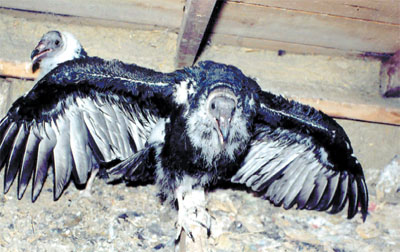
Approximately
55
and
51-
day-old
vultures,
31
August
2003,
near
Hairy
Hill. |
life
expectancy
and
where
the
vultures
will
nest
in
another
50
years
when
almost
all
of
these
old
buildings
have
finally
collapsed.
In
the
meantime,
we
ensure
that
the
landowners
are
aware
of
these
unique
and
interesting
creatures
inhabiting
their
buildings.
We
encourage
them
to
let
the
buildings
stand
for
as
long
as
possible.
A
few
of
the
landowners
are
planning
wintertime
repairs,
so
their
“vulturarium”
will
be
dry
and
durable
for
at
least
a
few
more
decades.
These
abandoned
farmsteads
are
often
used
by
a
variety
of
other
wildlife
species,
but
none
so
secretive
as
the
vultures.
|
Many
landowners
have
no
idea
that
these
huge
birds
are
nesting
in
their
abandoned
buildings.
Not
only
are
the
chosen
buildings
tucked
away
in
quiet
areas,
the
vultures
are
ultra-cautious
when
returning
home.
They
appear
to
scout
the
area
carefully
for
danger
from
afar
and
glide
a
number
of
lower
and
lower
sweeps
in
the
immediate
vicinity
before
finally
committing
themselves
to
land
at
their
nest
or
at
a
potential
food
item.
They
may
be
able
to
smell
a
person
who
remains
in
the
vicinity
of
their
nest,
hidden
in
a
blind
that
would
trick
almost
any
other
bird.
But
the
parent
vultures
do
return
to
care
for
their
youngsters
after
humans
have
departed
the
nest
site,
despite
any
whiff
of
human
odour
that
is
left
behind.
Usually
the
adults
are
not
present
when
we
visit;
perhaps
they
are
far
off
and
foraging.
Occasionally
one
or
both
have
appeared,
perched
in
a
distant
tree,
as
we
have
exited
their
nest
building.
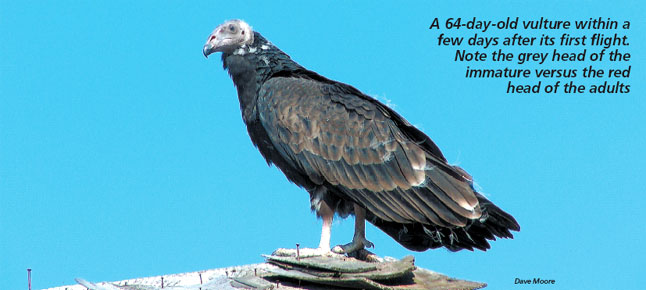
Productivity
and
site
fidelity
Of
the
nine
nests
we
visited
in
2003,
eight
held
two
nestlings
and
one
held
one,
for
a
total
of
seventeen.
In
2004
our
informants
brought
the
number
up
to
14
pairs,
of
which
seven
broods
had
two
nestlings,
three
had
one,
again
for
a
total
of
seventeen.
Of
the
other
four
pairs,
we
know
that
two
failed
during
incubation
(broken
or
abandoned
eggs)
and
from
their
behaviour
we
think
that
the
final
two
pairs
had
nestlings
close
by,
but
we
and
our
helpers
could
not
find
the
nests.
From
2003
to
2004,
two
pairs
moved
their
nests
nearby
and
the
other
seven
used
the
same
site
in
both
years.
In
2004
another
nest
was
used
after
a
lapse
of
at
least
three
years.
Of
the
sites
new
to
us
in
2004,
two
were
known
by
local
families
to
have
been
used
for
several
years
previously
and
one
was
definitely
a
new
site
with
the
amount
of
“whitewash”
on
the
walls
and
floor
representing
only
the
2004
brood.
Nesting
Range
In
Alberta,
vultures
are
documented
as
nesting
in
the
Grassland
Natural
Region
in
the
Cypress
Hills
near
Medicine
Hat
and
in
the
Big
Valley/Red
Deer
area.
In
the
Parkland
Natural
Region
they
nest
near
Chauvin
and
Wainwright,
near
the
North
Saskatchewan
River
south
of
St.
Paul
and
near
Duvernay,
south
of
Two
Hills
near
Hairy
Hill,
and
south
of
Waskateneau.
In
the
early
and
mid
1900s
vultures
nested
in
the
isolated
patch
of
dry
mixed-wood
to
the
southeast
and
east
of
Edmonton
at
Miquelon,
Ministik,
and
Astotin
Lakes.
In
the
main
body
of
the
dry
mixed-wood
portion
of
the
Boreal
Forest
Natural
Region,
a
ground-nest
of
vultures
was
found
in
Cold
Lake
Provincial
Park
in
the
1970s
and
more
recent
nests
in
buildings
have
been
found
near
Angling
Lake,
Ernestina
Lake,
the
Beaver
River
north
of
Bonnyville,
Moose
Lake,
Elk
Point,
St.
Paul,
and
in
the
1950s-1970s
at
Mann
Lakes.
The
Cold
Lake
and
Beaver
River
sites
are
the
farthest
north
nests
known.
Numerous
sightings
near
Lac
La
Biche
suggest
that
eventually
vultures
will
be
found
nesting
there
too,
pushing
the
breeding
range
farther
north.
To
date,
in
our
east-central
Alberta
study
area,
all
of
the
nests
have
been
within
a
rough
triangle
from
Provost
to
Edmonton
to
Cold
Lake,
with
the
bulk
of
the
nests
in
the
northern
half.
From
our
own
observations
and
those
of
others,
we
strongly
suspect
that
our
east-central
Alberta
population
of
vultures
is
increasing,
similar
to
but
much
more
discretely
than
the
recent
increases
in
the
common
raven,
osprey,
bald
eagle,
and
cougar
in
this
area,
perhaps
resulting
from
less
random
shooting
of
“varmints”,
less
poisoning
of
large
and
small
wildlife,
and
a
burgeoning
white-tailed
deer
population
with
its
abundant
road-kills.
Searching
for
vultures
In
Saskatchewan,
beginning
in
2003,
researchers
have
attached
wing
tags
to
nestling
vultures
when
they
were
nearly
full-grown.
Those
wing
tags
are
on
the
right
wing,
green
with
large
white
numbers
and
letters,
about
the
size
of
a
large
cattle
ear
tag,
and
are
readable
with
binocs
or
telescope
at
long
distances,
whether
the
vulture
has
its
wing
open
or
closed.
Please
report
sightings
of
wing-tagged
vultures
to
the
Bird
Banding
Office
at
1-800-327-BAND,
and
to
Stuart
Houston
at
(306)
244-0742
or
houstons@duke.usask.ca
We
may
be
able
to
undertake
a
similar
wing
tagging
program
in
Alberta
to
try
to
learn
about
movements,
fidelity
to
natal
areas,
age
at
first
breeding
and
many
other
aspects
of
the
lives
of
the
known
individuals.
If
we
can
locate
15-20
active
vulture
nests,
and
if
their
annual
return
to
those
nests
is
relatively
high,
we
may
be
able
to
efficiently
monitor
(say,
every
five
years)
the
productivity
and
health
of
this
population
and
the
health
of
that
very
interesting
part
of
the
environment
that
they
sample.
For
the
part
of
the
province
north
of
Highway
13
(Provost
-
Camrose
-
Pigeon
Lake
-
Alder
Flats),
we
request
reports
of
all
vulture
sightings,
and
especially
any
sightings
of
vultures
on
or
in
buildings.
Vultures
have
two
serious
chinks
in
their
secrecy
at
their
nest
sites,
which
allow
vigilant
observers
to
find
them.
In
mid-April
to
mid-
May,
having
just
arrived
back
from
Texas,
Mexico,
or
points
south,
adult
vultures
engage
in
several
weeks
of
courtship
with
followflights
and
other
aerial
displays.
But,
importantly,
they
spend
some
time
perched
on
the
roofs
or
in
the
windows
of
their
nest
building
or
in
large
trees
close
by.
In
mid-August
to
late-September,
young
vultures,
recently
out
of
the
nest,
perch
conspicuously
in
the
windows,
on
the
roof
and
near
their
nest
building,
between
practice
flights
in
the
area
and
while
awaiting
their
parents’
return
with
tasty
treats.
Charismatic
megafauna,
indeed!
Wayne
Nelson
is
the
Area
Wildlife
Biologist
for
the
Fish
and
Wildlife
Division
(FWD)
in
St.
Paul.
Floyd
Kunnas
is
the
Senior
Wildlife
Technician
for
the
Northeast
Region
FWD
in
St.
Paul.
Dave
Moore
is
the
Area
Wildlife
Biologist
for
FWD
in
Vermilion.
Contacts
for
vulture
sightings:
rwayne.nelson@gov.ab.ca
floyd.kunnas@gov.ab.ca
dave.moore@gov.ab.ca
|
|
|
|
|
|
|
|